The chess game had all the elements of football. But instead of a helmet, the quarterback had a crown on his head and was not guarded by 300-pound massive NFL linemen, but by tiny pawns. The pass-rushers were fast and heavy: the queen and two rooks flushed the quarterback out of the pocket and the scramble began. He could have been knocked down early, but escaped, running beautifully between and around the opponent's men deep into their territory. It was a mad rush, leading to a winning touchdown. When chess imitates life, it may even resemble American football.
The spectacular game was played between the Russian GM Alexander Riazantsev, who coached the former world champion Anatoly Karpov, and GM Sergey Karjakin, a former Ukrainian prodigy who settled in Moscow and now plays for Russia. It was so complicated even the chess computers sometimes hesitated to suggest the best way. How could have two human beings navigate their way through this mess? But they did brilliantly and with vigor.
It was the most dramatic clash at the tournament honoring Karpov in the Russian town of Poikovsky. It finished Sunday and the victory in this game helped Karjakin to share first place with Victor Bologan of Moldova. Both grandmasters scored 7-4, but Karjakin won the trophy on a better tiebreak.

Riazantsev - Karjakin
Queen's Indian defense
Poikovsky 2010
1.d4 Nf6 2.c4 e6 3.Nf3 b6 (The Queen's Indian, attempting to control the center with the Bishop from the square b7, was first worked out by Aron Nimzovich in the 1920s.) 4.g3 (Akiba Rubinstein's answer. White foresees the clash of the light Bishops on the long diagonal h1-a8.) 4...Ba6 (Nimzovich's aggressive idea, shifting the battlefield: Black puts pressure on the pawn on c4 and along the diagonal a6-f1.) 5.Qc2 (Previously considered meek, but the Queen move caught fire after it was connected with a gambit play. The original game Gruenfeld - Nimzovich, Breslau 1925, went 5.Qa4 c6 6.Bg2?! b5, expanding on the queenside.) 5...Bb7 6.Bg2 c5 7.d5!? (A modern pawn sacrifice, giving White some pressure against Black's entangled pieces. After 7.0-0 cxd4 8.Nxd4 Bxg2 9.Kxg2 Bc5 the light Bishops disappear and Black equalizes.) 7...exd5 8.cxd5 Nxd5 9.0-0 Be7
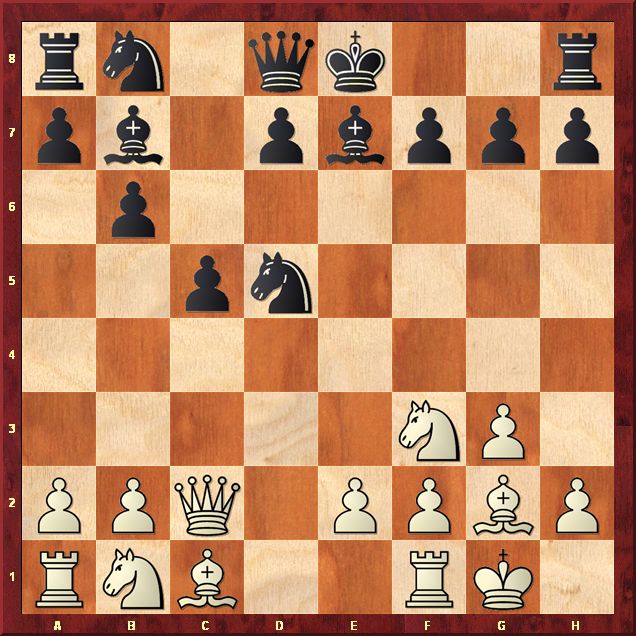
10.Qe4!? (A powerful pinning move, threatening to attack the knight on d5 with 10.Rd1, for example 10...0-0 11.Rd1 Na6 12.Rxd5 Nb4 13.Nc3 Bf6 14.a3 with White's advantage. The previously played 10.Rd1 can be matched by a tactical development 10...Nc6! as Karjakin played against Leko this year in Wijk aan Zee. The point is that 11.Rxd5? loses to 11...Nb4.) 10...Na6 (Planning to fortify the knight on d5 with 11...Nc7. Preventing a calamity along the h1-a8 diagonal with 10...Bc6 runs into 11.Ne5. White gains a bishop pair and has a strong pressure along the d-file. The weaker 10...Qc7 is met by 11.Nh4! Bc6 12.Nf5 g6 13.Nc3! gxf5 14.Nxd5 with White's advantage as in Sakaev - Ekstroem, Budva 2009.) 11.Nh4 g6 (Hoping to prevent 12.Nf5.)

12.Nf5! (Chess magic! The knight sacrifice gives the white Queen space along the fifth rank. In the game Svidler-Karjakin, Sochi 2008, White was pushed back after12.Qe5 f6 13.Qe4 Qc8 14.Rd1 Nac7 and the piece sacrifice 15.Nxg6?! hxg6 16.Qxg6+ Kd8 did not quite work. Karjakin won in 37 moves.) 12...gxf5 13.Qe5 0-0 (After 13...f6 14.Qxf5 White wins the piece back with dividends, threatening a picturesque mate 15.Qh5+ Kf8 16.Bh6+ Kg8 17.Qxd5+! Bxd5 18.Bxd5 mate.) 14.Qxf5 (Threatening to clobber the black King with 15.Be4, White is not in any hurry to regain the piece. After 14.Bxd5 Bf6 15.Qxf5 Bxd5 16.Qxd5 Nb4 17.Qb3 d5 Black has a strong center.) 14...Re8 15.Nc3 Nac7 (The tactical defense 15...Nxc3 16.Qg4+ Bg5 17.bxc3 h5?! does not work. After 18.Qxh5 black is in trouble, for example: 18...Bxg2 19.Bxg5 Re5 20.f4 Rxg5 21.fxg5 Bxf1 22.g6! Qf6 23.Qh7+ Kf8 24.Rxf1 and White wins; or 18...Bxc1 19.Bxb7 Qg5 20.Qf3 Rad8 21.Raxc1 with White's clear advantage.) 16.Be4 (Looking to create chaos around the black King. After 16.Nxd5 Bxd5 17.Bxd5 Nxd5 18.Qxd5 Bf6 Black's pieces are suddenly active and well placed.) 16...Bf6 17.Qxh7+! (White has to continue chasing the black King since after 17.Nxd5 Bxd5 18.Bxd5 Nxd5 19.Qxd5 Rxe2 Black is fine.) 17...Kf8 18.Bxd5 Bxd5 (Forced, since 18...Nxd5? leads to a splendid king's hunt: 19.Bh6+ Ke7 20.Qe4+! Kd6 21.Bf4+! Be5 [21...Nxf4? 22.Nb5 mate] 22.Nb5+! Kc6 23.Rfd1! Kxb5 24.a4+ Ka5 [24...Kc6 25.Bxe5! wins] 25.Qc4! Bc6 26.Rxd5, threatening 27.Bd2+ or 27.b4 mate.) 19.Nxd5 Nxd5 20.e4 (The black Knight doesn't have many good squares.)
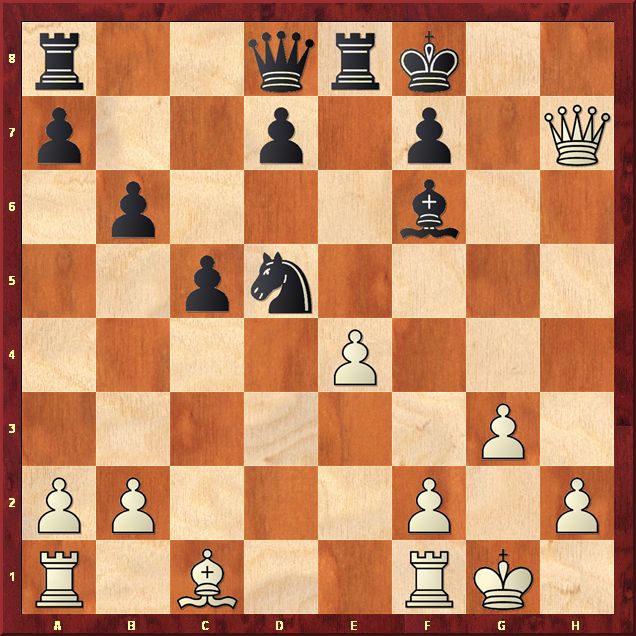
20...Nc7! (Aiming to protect the black King from the square e6. White gets a mating attack after 20...Nb4 21.Bh6+ Ke7 22.e5! Bxe5 23.Bg5+ Bf6 24.Qh6!, for example 24...Bxg5 25.Rfe1+ Be3 26.Rxe3 mate; or 24...Nd5 25.Rad1! Bxg5 26.Rfe1+ Be3 27.Rxe3+ Nxe3 28.Qd6 mate.) 21.Bh6+ Ke7 22.e5! (Opening the e-file makes the black king uncomfortable.) 22...Bxe5 23.Qe4! (The only way to continue the assault. After 23.Bg5+ Bf6 24.Rfe1+ Ne6 25.Rxe6+! dxe6 26.Bxf6+ Kxf6 27.Qh6+ Ke7 28.Qh4+ Kf8 forces White to take a perpetual check.)
23...f6 (After 23...Kf6? White accelerates the attack with a beautiful deflection 24.Bg5+!, for example 24...Kxg5 25.f4+ Kh6 26.fxe5 and now white should win either after 26...d5 27.Qg4 Rxe5 28.Rxf7 Qg5 29.Qh3+ Qh5 30.Qd7 Qg6 31.Qxc7; or after 26... Qe7 27.Rf5 Kg7 28.Qg4+ Kf8 29.Raf1 Qe6 30.Qh5 and the attack breaks through.) 24.f4 d5 (Building a protective pawn wall. After 24...Rh8 25.Bg7 d5 26.Qe2 Kf7 27.fxe5 Kxg7 28.Qg4+ Kf7 29.Rxf6+ win.) 25.Qh7+ Kd6 26.fxe5+ fxe5 27.Rf7 Ne6 ( A picturesque position!)
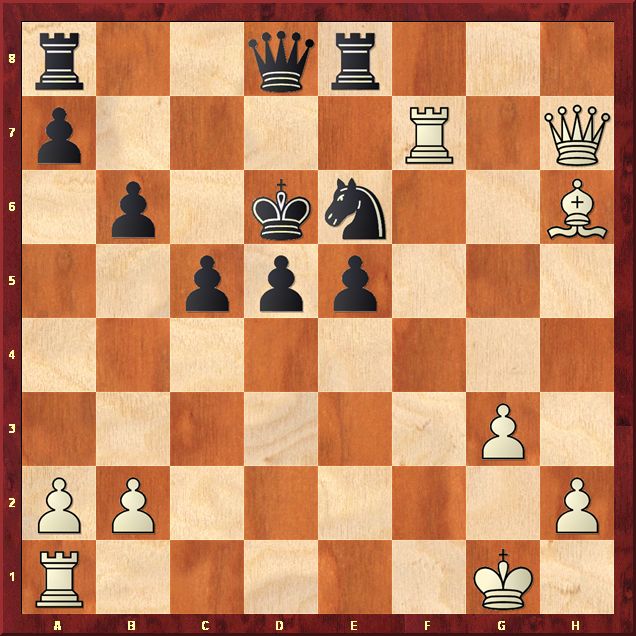
(Is the line of the pawns in front of the black King powerful enough to endure White's assault or is it going to be as porous as the offensive line of last year's Washington Redskins, breaking on the first hard push?) 28.Qg6 (28.Qf5 or 28.Raf1 can be met by 28...Re7.) 28...Kc6 (Attempting to exchange Rooks with 28...Re7 runs into 29.Bg5! Rxf7! 30.Bxd8 Rg7 31.Bc7+ Rxc7 32.Rf1 and White has the edge.) 29.Raf1 d4 (Planning to help the defense by centralizing the Queen on the square d5. Running away with the King 29...Kb5 invites a mating attack after 30.a4+!, for example 30...Ka6 31.b4! Nd4 32.b5+ Ka5 33.Qd3 c4 34.Ra1! cxd3 35.Bd2 mate; or 30...Kxa4 31.Qd3 c4 32.b3+! Kb5 33.bxc4+ dxc4 34.Rb1+ Kc5 35.Qa3+ Kd5 36.Qf3+ Kd6 37.Be3!, threatening 38.Rd1+.) 30.R1f6! (The pin is a big problem for Black. It freezes the knight.) 30...Qd5 (Protecting the Knight, but allowing a tactical punch. After 30...Kd5 31.b3 b5 32.Qh7 Qc8 33.Rd7+ Kc6 34.Rff7 White wins.)
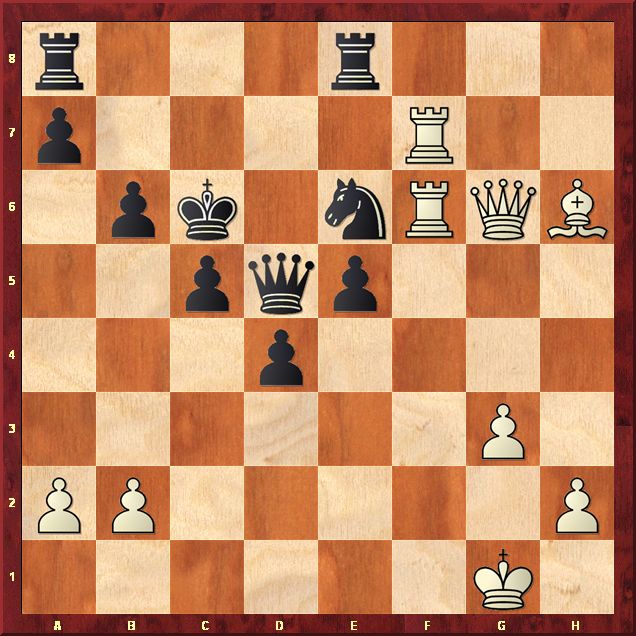
31.Rxa7! (The Rook is tabu and the black King is now being rushed from both sides.) 31...Rad8 (After 31...Rxa7 32.Qxe8+ Kd6 33.Bf8+ wins.) 32.a4!? (White has the desire to control as many squares as possible around the black King, but it seems that 32.Bf8!, threatening to complete the siege of the knight with 33.Be7, was much stronger. After 32...Rxf8 33.Rxe6+ Rd6 34.Rae7! White should win, for example 34...Rxe6 35.Rxe6+ Kd7 36.Rxb6 d3 37.Qg7+ Rf7 38.Qxf7+ Qxf7 39.Rb7+ Ke6 40.Rxf7 Kxf7 41.Kf2; or 34...Rfd8 35.Rxd6+ [35...Qxd6 36.Re6!] Rxd6 36.Qe8+ Rd7 37.Qc8+. The powerful 32.Qf7 also leads to victory.) 32...c4 (Black could have made it more difficult with 32...d3 33.Qf7 Qd4+ 34.Kg2 Kd6. Imagine the despair on White's face after 35.Qc7+ Kd5 36.Qb7+ Kc4 37.Qxb6 Qd5+ 38.Rf3 [38.Kg1? is even worse: 38...Rb8 39.Qa6+ Kb3 40.Qa5 Nf4!! 41.Rb6+ Ka2 and Black wins.] 38...e4 39.Qb5+ Kd4 40.Be3+ Ke5, seeing that the black King in the middle is safe. And who would guess that the innocent-looking King move 35.Kh3! seals the win.)
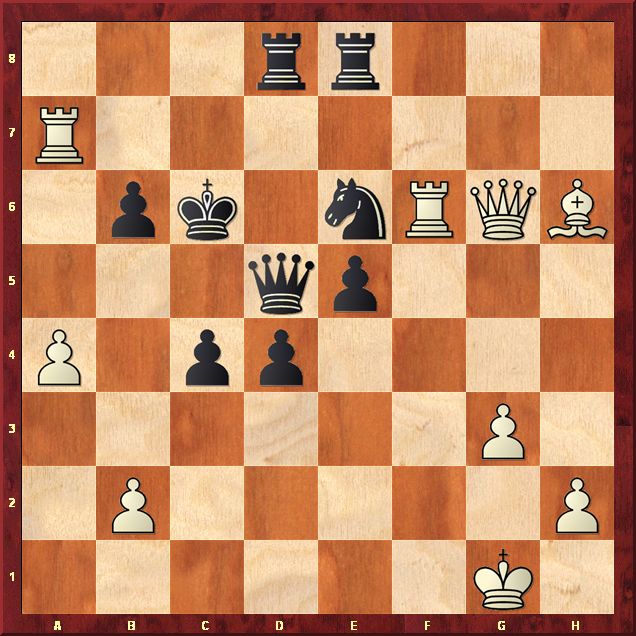
33.Qf7? (Chess is a confusing game. Why the same move that worked wonderfully on the previous turn suddenly doesn't cut it? Because White could have woven a mating net with 33.Bf8!, controlling the dark squares and threatening - to confuse you even more - 34.Qf7! and 35.Qc7 mate. Black does not have a good defense, for example 33...Rxf8 34.Rxe6+ Rd6 35.Qh7! [Not 35.Qg7? Rf1+! 36.Kxf1 Qf3+ 37.Kg1 Qd1+ 38.Kf2 Qd2+ 39.Kf3 Qd1+ with perpetual check.] 35...Qxe6 36.Qb7+ Kc5 37.Ra5+! Kb4 [37...bxa5 38.Qb5 mate] 38.Rb5+ Kxa4 39.Qa6 mate.) 33...Kc5! (Running for life! The scramble begins) 34.Bd2 (It seems that 34.Rc7+! is the right way to go, for example 34...Nxc7? 35.Qxc7+ Kb4 36.Qxb6+ Kxa4 37.Qa6+ Kb3 38.Qa3+ Kc2 39.Rf2+ Kb1 40.Rf1+ Kc2 41.Rc1 mate, but and after 34...Kb4! White has to find 35.Re7! with winning chances.) 34...c3 35.Rc7+?! (The simple capture 35.bxc3! is much better, for example 35...dxc3 36.Bxc3 Kc4 37.Be1 Qe4 38.Rc7+ Kb3 39.Rc3+ Kb2 40.Rf2+ Kb1 41.Rb2+! Kxb2 42.Qf2+ and White mates.) 35...Kb4 (The luck is slowly turning in Black's favor.) 36.bxc3+ (White could have tried to bring the Queen back with 36.Rxe6!? Rxe6 [36...Qxe6 37.Qf1!] 37.bxc3+ dxc3 38.Bxc3+ Kxa4 39.Qf2 with chances to equalize.)
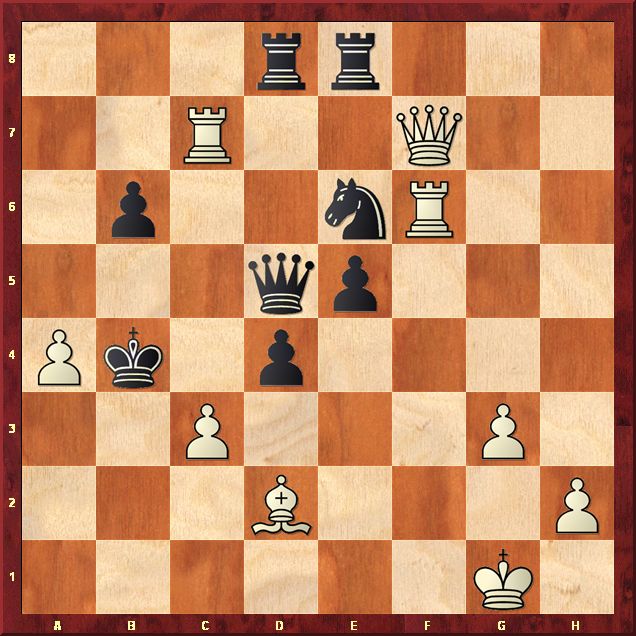
36...Kb3?! (Can the black King find a better hiding place after 36...dxc3! 37.Bxc3+ Ka3? The bishop sacrifice 38.Bb2+! may lead to a draw, for example 38...Kxb2 39.Rf2+ Ka3 40.Rc1! Qe4 41.Ra2+!! Kxa2 42.Qf2+ Kb3 43.Qxb6+ Ka2 [43...Ka3 44.Ra1 mate.] 44.Qf2+ Kb3 45.Qb6+ with a perpetual check.) 37.c4! (Better seems 37.Qg6 d3 38.Rcf7, but the shocking 38...Nf4! opens up the white King and Black wins.) 37...Qd6 38.Rb7 (Too slow. White should have tried 38.Rxe6!?, for example 38...Rxe6 39.Qf1! Kc2 40.Rf7!, forcing a perpetual check after 40...Kxd2 41.Rf2+ Kc3 42.Qc1+ Kb4 43.Qb2+ Kxc4 [43...Kxa4 44.Rf1! wins] 44.Qb5+ Kc3 45.Qb2+ etc.; or 38...Qxe6 39.Qf3+ and Black has to be careful since after 39...Kb2?! 40.Qd1 Qg6 41.Bc1+ ! Ka1 [or 41...Kb1 42.Rc6! Qxc6 43.Qd2 and 44.Qb2 mate] 42.Rf7! Qb1 43.Rf2 and White wins.) 38...d3 39.a5 Qd4+ 40.Kf1 Qe4 (Stepping in with 40...Kc2 is more precise, for example 41.Rxb6 Kxd2 42.Qb7 Rb8; or 41.Rf2 Qe4! 42.Bh6+ d2 and Black wins.) 41.Kg1 (After 41.Rxb6+ Kc2 42.Rbxe6 Black wins with 42...Qh1+ 43.Kf2 Qxh2+ 44.Kf1 Rg8! 45.Rf3 Rdf8 46.Qxf8 Rxf8 47.Rxf8 Qh3+, picking up the Rook on e6.) 41...Kc2! (The King turns into a powerful attacker and decides the game.)
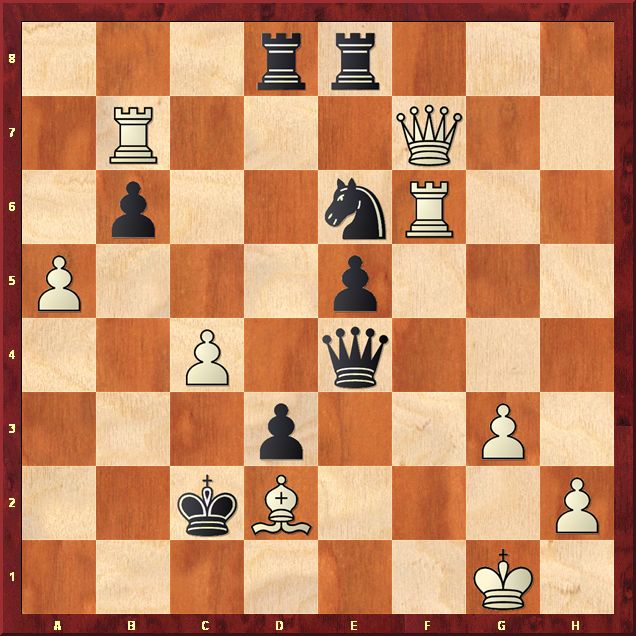
42.Rxb6 (It is too late for 42.Re7 Rxe7 43.Qxe7 Kxd2 44.Rxe6 Qd4+ 45.Kg2 Kc2 46.Qh7 Kc3; or for 42.Rf2 Rf8! 43.Bb4+ d2 44.Bxf8 Rxf8 winning.) 42...Kxd2 43.Rbxe6 Rxe6 44.Qxe6 Kc2 45.c5 Qd5! (A simple winning solution, preventing the white Queen from going to a2. The d-pawn just rolls down.) 46.Qg4 (Black wins either after 46.Qf5 e4 47.Qf1 d2; or after 46.Qxd5 Rxd5 47.a6 Rd7 stopping the white pawns and promoting his own.) 46...Qd4+ 47.Rf2+ d2 48.Qf3 e4 49.Qf7 Kc3 (White can't stop the touchdown 50...d1Q.) White resigned.
The game would make a great addition to Colin Crouch's new book "Modern Chess: move by move," published by Everyman Chess http://www.everymanchess.com/ last year. It is a well-written collection of 33 brilliant games, played by some of the best grandmasters in the world. It is another of Crouch's gem - 400 pages of great analysis and wonderful text. Recommended for tournament players.
For replaying the game:
Note that in the replay windows below you can click on the notation to follow the game.
No comments:
Post a Comment